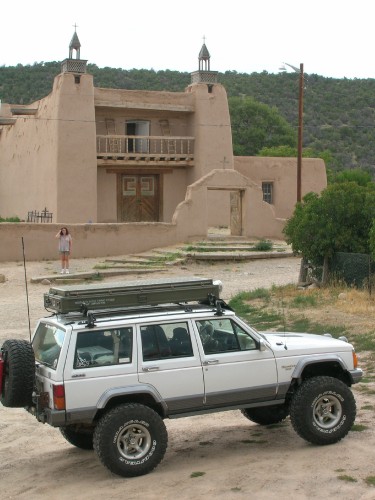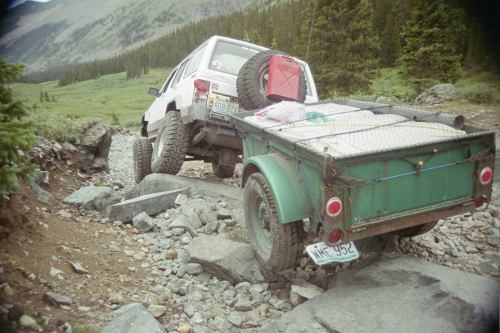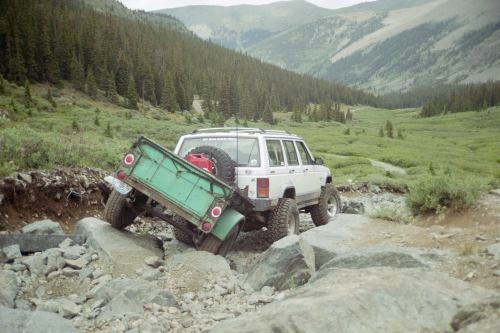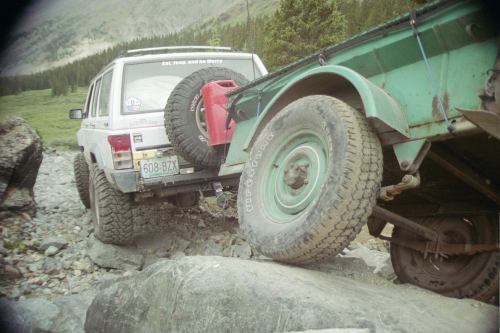RKBA
NAXJA Member #1012
- Location
- Outer Banks, NC
Anyone who claims that the jumbo rooftop carriers don't dramatically impact fuel economy either don't really check their mileage or have a hard time telling the truth.
The aero drag on the roof with those larger boxes is SIGNIFICANT and WILL drastically decrease mpg as well as make a lifted XJ loads of fun to drive on windy days. I have no experience with the low profile Yakima boxes, they may be a reasonable compromise, but do they hold enough crap to bother with? They don't look like it to me.
My suggestion would depend on how much crap you are carrying. if you can fit it in a rooftop sized box and like to drive extra-legal speeds, then a rear mount hitch-haul (with a box) is the way to go. It will block hatch access, but you don't take the mpg hit and can get to the stuff easier.
Personally I believe a 4x8 medium duty utility trailer is one of the best Jeep accessories ever made. It makes any bobtail 4x4 the cargo equal of a one ton truck whenever you need it. Another slick little set up would be to drop a used Sears cargo box on one of those little red Chinese 48" trailers that Harbor Freight sells for $149. Guys with motorcycles can tow that so I doubt it weighs more than four hundred pounds fully loaded.
As someone else mentioned, state laws and good sense dictate that you drive a little slower when towing. In my experience towing trailers with low frontal area, the slightly lower speed makes the towing mpg hit almost nil. My pop-up weighs in at ~1500 lbs camping weight and my XJ has 32s/4.56s/AW4. If I drive 70 when unladen, I get right on 18-19 mpg. When towing the Jayco and keeping it at 65 or under, the XJ will give me 17-18 pretty consistently on the flats and 15-17 in the hills.
The aero drag on the roof with those larger boxes is SIGNIFICANT and WILL drastically decrease mpg as well as make a lifted XJ loads of fun to drive on windy days. I have no experience with the low profile Yakima boxes, they may be a reasonable compromise, but do they hold enough crap to bother with? They don't look like it to me.
My suggestion would depend on how much crap you are carrying. if you can fit it in a rooftop sized box and like to drive extra-legal speeds, then a rear mount hitch-haul (with a box) is the way to go. It will block hatch access, but you don't take the mpg hit and can get to the stuff easier.
Personally I believe a 4x8 medium duty utility trailer is one of the best Jeep accessories ever made. It makes any bobtail 4x4 the cargo equal of a one ton truck whenever you need it. Another slick little set up would be to drop a used Sears cargo box on one of those little red Chinese 48" trailers that Harbor Freight sells for $149. Guys with motorcycles can tow that so I doubt it weighs more than four hundred pounds fully loaded.
As someone else mentioned, state laws and good sense dictate that you drive a little slower when towing. In my experience towing trailers with low frontal area, the slightly lower speed makes the towing mpg hit almost nil. My pop-up weighs in at ~1500 lbs camping weight and my XJ has 32s/4.56s/AW4. If I drive 70 when unladen, I get right on 18-19 mpg. When towing the Jayco and keeping it at 65 or under, the XJ will give me 17-18 pretty consistently on the flats and 15-17 in the hills.








